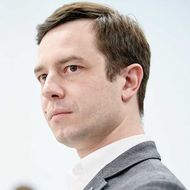Generation Z's Digital Revolt: HSE Examines a Million Messages from Nepali Social Media

In September 2025, young people in Nepal took to the streets, armed not with party slogans but with online chats. Researchers at HSE analysed a million messages on a Discord server to understand the mechanics of youth protest. Experts discussed why the protesters identified themselves as Generation Z and what lessons can be drawn from this experience.

Dmitry Zemtsov
The HSE 'Youth Policy' Laboratory organised a seminar on 'Protests in Nepal: The Role of Youth.' 'Today we have an unusual seminar: for the first time we are delving deeply into international issues and discussing foreign youth,' said HSE Vice Rector Dmitry Zemtsov in his opening remarks. Traditionally, the 'Youth Policy' Laboratory focuses on Russian issues, but this time the experts turned their attention to Nepal—the reason being the large-scale protests in which young people played a decisive role.
The seminar featured two reports: 'Protests in Nepal: Causes, Consequences, and the Role of Youth' and 'The Digital Footprint of Protests in Nepal.' The latter was based on research conducted by the HSE team through an analysis of online discourse. 'At our previous seminar, we argued that the concept of generations was outdated. And literally a week later, the world’s press was talking about Generation Z. We decided to check what really lay behind these events,' explained Dmitry Zemtsov.

Ernest Novinskii
Ernest Novinskii, Nepal specialist and Junior Research Fellow at MGIMO’s Institute of International Studies, gave a detailed overview of the history of political protests in the country. According to him, mass demonstrations have been part of Nepal’s political culture since the mid-20th century. The first protests were organised by the Nepali Congress and left-wing forces, but after a brief spell of parliamentarism, power once again reverted to the monarchy. For decades, opposition parties operated underground.
A turning point came in the 1990s, when the new People’s Movement succeeded in restoring parliament. However, stability never followed. 'Cabinets changed at a frightening pace. Political life turned into a constant game of musical chairs,' the speaker stressed. The country eventually plunged back into crisis: Maoists launched an armed uprising, and in 2005 the king attempted to reassert his authority. This only hastened the fall of the monarchy: in 2006, following mass protests, Nepal became a republic.
Seventeen years have passed since then, but according to Ernest Novinskii, the expectations of Nepal’s citizens have not been met. 'Not a single revolution has led to reform of the bureaucratic system. The old officials remain in place, and corruption and favouritism are still the norm,' he explained. The three main parties have in effect monopolised power, forming coalitions and dividing posts among themselves.
Socio-economic problems have only made matters worse. Each year, 500,000 young Nepalis enter the labour market, yet only about 100,000 jobs are created. The rest are forced to seek work abroad: last year alone 800,000 permits to leave the country were issued. 'The government was quite open: since there is no work, look for it abroad. This fuels large-scale labour migration and heightens social discontent,' the expert noted. At the same time, corruption scandals follow one after another, eroding trust in the authorities and pushing young people towards active protest.
The defining feature of the current movement has been the participation of young people who grew up in the digital age. 'On the streets of Nepal today are the children of those who protested in 2006. They do not believe in the old political parties,' the expert remarked.
According to Ernest Novinskii, it was digitalisation that gave the protests their mass character. In 2008, only 2 per cent of Nepal’s population used the internet; today the figure is over 55 per cent. In major cities, most residents own smartphones, which have become the main tool of mobilisation. 'Social media has become the principal channel of communication. Young people aged 18 to 34 found themselves at the vanguard of the protests,' he explained.
The key discovery of the study was the role of the cross-platform instant messaging service Discord. 'The international press portrayed the protest as a reaction to the blocking of messaging apps. But the reality is far more complex. Discord became the venue where everything was discussed—from memes to nominating candidates for prime minister,' said Dmitry Zemtsov.

Ilya Yaskov
Linguist, data analyst, and Deputy Vice Rector of HSE University Ilya Yaskov explained in detail how the data had been processed: 'We downloaded one million messages, 100 megabytes of text, and 300 megabytes of images. It is impossible to process such a volume manually, so we used artificial intelligence. Modern technologies allow us to identify the main topics and the dynamics of events within just a few hours.'
Ilya Yaskov pointed out that Discord, originally created for gamers, proved to be an ideal environment for self-organisation. 'Topic-specific channels, voice chats, moderation of discussions—all of this made it possible to coordinate hundreds of thousands of participants. It is a unique example of a gaming platform turning into a political instrument,' he explained.
The first mass slogans and calls to action appeared even before the creation of the Discord server; they were actively promoted by fake accounts using generative content. At the early stage, researchers observed a wave of generative content—'automatic influencers' who fuelled discontent and spread protest hashtags. This culminated in the demonstrations of September 8, which ended in fatalities. Researchers suggest this may have been a case of social technology in action.
Members of the spontaneously formed Gen Z community deliberately distanced themselves from political parties: one of the group’s key demands was the absence of any ties to existing political forces. Moreover, chat participants positioned themselves in opposition to the organisers of the unrest ('the third side' in their terminology), officially declaring that they were neither engaged in street violence nor acts of vandalism. Seeking to pursue political aims while reducing the level of violence, protesters actively cooperated with the army from the very first days, passing on information about incidents of street disorder that they were aware of.
Contrary to reports in the international mass media, the ban on social networks was not the trigger for the protests—it was merely the backdrop. The real causes lay in accumulated socio-political contradictions, and the spark was the deaths that occurred on September 8, 2025.
Gen Z was not a political movement, but a temporary actor that emerged in the context of crisis. Young people came together spontaneously. By September 14, chat activity had already declined significantly, as the social structure of the protest had exhausted itself. Once the key events were over, the community quickly began to dissipate.
Unlike earlier protests, the current movement had no clearly defined leader. Chat moderators enjoyed situational popularity, but for the most part did not convert it into political capital. The few exceptions—such as Sudan Gurung, organiser of the Discord chats—only proved the rule: attitudes towards him among participants ranged from respect to suspicion. Interestingly, the protesters even held a 'vote' for a new government on Discord. Yet this brought no real change: the average age of the 'new ministers' turned out to be 60, meaning a generational shift failed to take place.
According to experts, Nepal’s main problem is the lack of social mobility.
'Political life remains closed off. Youth wings of parties are either purely nominal or composed of the children of current politicians. This keeps power in the hands of a narrow circle of families and clans,' explained Ernest Novinskii.
The study showed that, for now, analogue politics has proved stronger than digital socio-technology. Nevertheless, figures from within the protest environment are gradually moving into the public sphere. Sudan Gurung has already been received by the president, and it is possible that he and his team may demonstrate political ambitions in the elections.
Summing up the seminar, Dmitry Zemtsov noted: 'We are striving to build a system of evidence-based youth policy. The case of Nepal shows that ignoring its digital dimension is unacceptable.'
At present, HSE researchers are observing that protesters in Morocco are making use of Discord infrastructure in a way similar to the Nepali scenario. The Gen Z 212 server, which since September 28 has gathered more than 100,000 users, has a chat structure closely resembling that of the Nepali server, while the principles of moderation also share a number of similarities. This may indicate the emergence of a new social technology for organising protests.
See also:
AI Can Predict Student Academic Performance Based on Social Media Subscriptions
A team of Russian researchers, including scientists from HSE University, used AI to analyse 4,500 students’ subscriptions to VK social media communities. The study found that algorithms can accurately identify both high-performing students and those struggling with their studies. The paper has been published in IEEE Access.
Artificial Intelligence Can Now Predict Students’ Educational Outcomes Based on Their VK Posts and Tweets
The new model, created by computational social scientist Ivan Smirnov of HSE University, predicts the academic success of Russian high school students with an accuracy of 94%. The model generates its predictions based on users’ distinctive vocabulary and speech patterns, and the predictions have strongly correlated with students’ Unified State Exam (USE) scores.
UNESCO Report on Global Press Freedom Presented at HSE
The presentation of UNESCO's report ‘Global Trends in Freedom of Expression and Mass Media Development’ was held at the Higher School of Economics. It was an opportunity to discuss journalism and the growing gap between traditional regulators and modern consumers of media.
Instagram Micro-celebrities: What Factors Contribute to Online Endorser Credibility and Influence Consumer Behaviour?
Physical attractiveness, high-quality photos, interesting content, engagement with the audience, and subject competence are the key contributing factors to Instagram micro-celebrities' success, according to a study which examines the influence of online celebrity endorsers on consumer purchase intentions.
Professor Explores Links between Literature, Landscape and the Natural World
On May 15, Dr James Canton of the University of Essex will deliver a lecture at HSE on ‘Wild Writing’, a form of literature that emerged in the mid-twentieth century as a novel way of understanding the urban landscape and nature. The author of numerous publications focused primarily on British travel writing in Arabia, Dr Canton’s lecture will focus on a discussion of local Essex landscapes.


